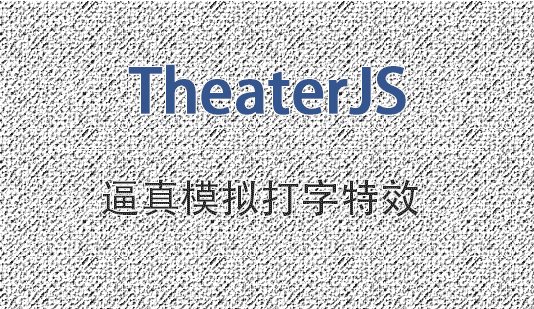回顾上篇文章"谈谈Text的一些交互体验",其中提到文字的特效:打字效果,今天主要分享如何实现这种酷炫的效果。
我们需要用到一款插件:TheaterJS。TheaterJS能逼真模拟打字特效应用。

使用方法
可以使用下面的js代码来调用TheaterJS制作打字机效果:
var theater = new TheaterJS();
theater
.describe("Vader", .8, "#vader")
.describe("Luke", .6, "#luke");
theater
.write("Vader:Luke.", 600)
.write("Luke:What?", 400)
.write("Vader:I am...", 400, " your father.");
theater
.on("say:start, erase:start", function () {
// add blinking caret
})
.on("say:end, erase:end", function () {
// remove blinking caret
})
.on("*", function () {
// do something
});
多重角色
使用TheaterJS,你可以建立多个角色,每个角色都有自己的"经验",它们使用这些"经验"可以互相"交谈"。
theater.describe("Vader", .8, "#vader");
上面的代码描述了一个新的角色,名字叫"Vader",它的"经验"值为0.8(必须是0-1之间),它的voice是"#vader"。voice将用于打印的文字,Vader是一个html元素。
voice可以是两种类型:
-
一个HTML元素(或一个CSS选择器),元素的
innerHTML将被用于设置voice。 -
用4个参数调用的函数:
-
newValue:新的speech值。
-
newChar:新的打印字符。
-
prevChar:前一个字符。
-
speech:所有的speech。
-
注意:当TheaterJS调用了这些函数,上下文this被设置为当前对象。
创作剧本
TheaterJS实际上是在创建一个剧本。
theater
.write("Vader:I am your father.")
.write(" For real....")
.write(-1)
.write(600)
.write(function () { /* do something */ });
注意:write方法接收不定数量的参数。
theater
.write("Vader:Hello!")
.write("How are you doing?");
等效于
theater.write("Vader:Hello!", "How are you doing?");
设置 actor 和 speech
theater.write("Vader:I am your father.");
write方法的参数是以角色的名字为前缀的字符串。它实际上添加了三个场景:
| 场景名称 | 描述 | |-------|---------------------------------------------------| | actor | Set the current speaking actor to the passed one. | | erase | Erase the current speech value. | | actor | Type the speech. |
场景对象
theater
.write("Vader:I am your father.")
.write(" For real....")
.write(-1)
.write(600)
.write(function () { /* do something */ });
它等效于
theater
.write({ name: "actor", args: ["Vader"] })
.write({ name: "erase", args: [] })
.write({ name: "say", args: ["I am your father."] })
.write({ name: "say", args: [" For real...."] })
.write({ name: "erase", args: [-1] })
.write({ name: "wait", args: [600] })
.write({ name: "call", args: [function () { /* do something */ }] });
事件
TheaterJS有一些内置的事件。
theater
.on("say:start", function (event, args...) {
console.log("a say scene started");
})
.on("say:end", function (event, args...) {
console.log("a say scene ended");
});
在 : 之前的值是事件的作用域,其它部分是事件本身。要添加一个事件监听,可以使用逗号隔开它们。
theater
.on("say:start, erase:start", function (event) {
// add blinking caret
})
.on("say:end, erase:end", function () {
// remove blinking caret
});
如果你想监听所有的事件,使用theater.on("*", function (event, realEvent, args...) {});方法。
公共方法
theater
.emit("scope", "event", ["your", "arguments", "go", "here"])
.emit("customEvent", ["you might not need the event part"]);
emit方法接收三个参数:第一个是作用域,第二个是事件,第三个是参数。
案例
掌握上面的基础知识,我们再回顾下上篇文章的例子:
<!doctype html><head><meta charset="utf-8"><meta http-equiv="X-UA-Compatible" content="IE=edge,chrome=1"><title>移动支付正在维护中 - Web前端之家</title><meta name="keywords" content="" /><meta name="description" content="" /><meta name="viewport" content="width=device-width, initial-scale=1.0, maximum-scale=1.0, user-scalable=0" /><link href="/demo/dazi/d1/css/lp228.css" rel="stylesheet" type="text/css"></head><body><script type="text/javascript">
function recalc() {
var x = 750,clientWidth = document.body.clientWidth;
if (!clientWidth) return;
document.documentElement.style.fontSize = 100 * (clientWidth / x) + 'px';
};
if (window.addEventListener) {
recalc();
var resizeEvt = 'orientationchange' in window ? 'orientationchange' : 'resize';
window.addEventListener(resizeEvt, recalc, false);
}</script><div class="cen-loading-box">
<p class="cen-p-fon">移动支付正在维护中,带来不便,敬请谅解</p>
<p class="cen-p-fon2">请您用<strong>电脑登录客户中心</strong>进行存款</p>
<div class="cen-comp-box scene">
<div class="inp-fon" id="vader"></div>
</div>
<pre id="nodebug" style="display:none"><code>
theater.write( <span id="log"></span>
); </code></pre></div><script src="/demo/js/jq.js"></script><script src="/demo/dazi/d1/js/theater.min.js"></script><script type="text/javascript">
(function () {
"use strict";
var $log = document.querySelector("#log");
var theater = new TheaterJS();
theater .describe("Vader", .8, "#vader");
theater .on("*", function (eventName, originalEvent, sceneName, arg) {
var args = Array.prototype.splice.apply(arguments, [3]),
log = '{\n name: "' + sceneName + '"';
if (args.length > 0) log += ",\n args: " + JSON.stringify(args).split(",").join(", ");
log += "\n }";
$log.innerHTML = log;
})
.on("say:start, erase:start", function (eventName) {
var self = this,
current = self.current.voice;
self.utils.addClass(current, "saying");
})
.on("say:end, erase:end", function (eventName) {
var self = this,
current = self.current.voice;
self.utils.removeClass(current, "saying");
});
theater .write("Vader:Web前端之家", 2000)
.write(function () { theater.play(true); });
})();</script></body></html>本段代码来自 https://www.jiangweishan.com/article/textBasicYingyong.html
是不是感觉一目了然了呢。
总结
文字的特效有很多,TheaterJS是我比较喜欢的一种,如果您有更好的,可以分享出来,一起学习探讨!!!记得加入我们前端群295431592。
 51工具盒子
51工具盒子




